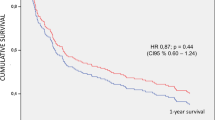Summary
This is the case report of an 80-year-old woman with advanced chronic obstructive pulmonary disease (COPD), multimorbidity and frailty. Despite regular critical re-evaluation of on-going medication, a significant reduction of prescribed medication was not achieved up until the patient’s terminal phase, and this may have contributed to several episodes of delirium. It was particularly difficult to reduce the number of prescribed drugs due to cardiovascular, endocrinologic, orthopaedic, neurologic, psychiatric and pulmonary comorbidities. Probable drug–drug interactions and side effects were repeatedly observed. This case report aims to describe a dilemma frequently encountered in the care of patients with progressed pulmonary disease in the context of frailty and multimorbidity.
Zusammenfassung
Dargestellt wird der Fall einer 80-jährigen Frau mit weit fortgeschrittener chronisch obstruktiver Lungenerkrankung (COPD), Multimorbidität und Gebrechlichkeit. Trotz regelmäßiger kritischer Reevaluierung der laufenden Medikation wurde eine relevante Reduktion der verordneten Medikamente bis kurz vor dem Tod der Patientin nicht erreicht, und dies trug wahrscheinlich zu wiederholten Episoden eines Delirs bei. Aufgrund von endokrinologisch, kardiovaskulär, orthopädisch, neurologisch, psychiatrisch und pulmonal bedingter Multimorbidität war es besonders schwierig, die Anzahl der Medikamente zu reduzieren. Mögliche Interaktionen und Nebenwirkungen wurden wiederholt beobachtet. In der vorliegenden Falldarstellung zeigt sich ein Dilemma, dass sich in der Betreuung von Patienten mit weit fortgeschrittener Lungenerkrankung und begleitender Multimorbidität und Gebrechlichkeit häufig stellt.
Similar content being viewed by others
References
Morin L, Vetrano DL, Rizzuto D, Calderón-Larrañaga A, Fastbom J, Johnell K. Choosing wisely? Measuring the burden of medications in older adults near the end of life: nationwide, longitudinal cohort study. The American Journal of Medicine. 2017. http://linkinghub.elsevier.com/retrieve/pii/S000293431730253X. Accessed 6 May 2017.
Alzner R, Bauer U, Pitzer S, Schreier MM, Osterbrink J, Iglseder B. Polypharmacy, potentially inappropriate medication and cognitive status in Austrian nursing home residents: results from the OSiA study. Wien Med Wochenschr. 2016;166(5–6):161–5.
Global Initiative for Chronic Obstructive Lung Disease (GOLD). The global strategy for the diagnosis, management and prevention of COPD. 2017. http://goldcopd.org. Accessed 9 May 2017, Chapter 6.
Riesinger R, Iglseder B. Tools zur Therapieoptimierung bei multimorbiden geriatrischen Patienten am Lebensende – Hilfe oder „nur“ Denkanstoß? Wien Med Wochenschr. 2014;164(9–10):189–94.
Roblek T, Vaupotic T, Mrhar A, Lainscak M. Drug-drug interaction software in clinical practice: a systematic review. Eur J Clin Pharmacol. 2015;71(2):131–42.
Tamblyn RM, McLeod PJ, Abrahamowicz M, Laprise R. Do too many cooks spoil the broth? Multiple physician involvement in medical management of elderly patients and potentially inappropriate drug combinations. CMAJ. 1996;154(8):1177–84.
George NR, Kryworuchko J, Hunold KM, Ouchi K, Berman A, Wright R, et al. Shared decision making to support the provision of palliative and end-of-life care in the emergency department: a consensus statement and research agenda. Acad Emerg Med. 2016;23(12):1394–402.
American Psychiatric Association. Diagnostic and Statistical Manual of Mental Disorders. 5th ed. cited: American Psychiatric Association; 2013. Available from: http://psychiatryonline.org/doi/book/10.1176/appi.books.9780890425596.
Inouye SK, Westendorp RG, Saczynski JS. Delirium in elderly people. Lancet. 2014;383(9920):911–22.
Ahmed S, Leurent B, Sampson EL. Risk factors for incident delirium among older people in acute hospital medical units: a systematic review and meta-analysis. Age Ageing. 2014;43(3):326–33.
Elie M, Cole MG, Primeau FJ, Bellavance F. Delirium risk factors in elderly hospitalized patients. J Gen Intern Med. 1998;13(3):204–12.
Gorski S, Piotrowicz K, Rewiuk K, Halicka M, Kalwak W, Rybak P, et al. Nonpharmacological interventions targeted at delirium risk factors, delivered by trained volunteers (medical and psychology students), reduced need for Antipsychotic medications and the length of hospital stay in aged patients admitted to an acute internal medicine ward: pilot study. Biomed Res Int. 2017;2017:1297164.
Campbell ML, Templin T, Walch J. A respiratory distress observation scale for patients unable to self-report dyspnea. J Palliat Med. 2010;13(3):285–90.
Global Initiative for Chronic Obstructive Lung Disease (GOLD). The global strategy for the diagnosis, management and prevention of COPD. 2017. http://goldcopd.org. Accessed 9 May 2017, Chapter 6.
Garfinkel D, Mangin D. Feasibility study of a systematic approach for discontinuation of multiple medications in older adults: addressing polypharmacy. Archives of internal medicine. 2010. Available from: http://archinte.jamanetwork.com/article.aspx?doi=10.1001/archinternmed.2010.355. Accessed 14 Jan 2018, Available from: http://archinte.jamanetwork.com/article.aspx?doi=10.1001/archinternmed.2010.355.
O’Mahony D, O’Connor MN. Pharmacotherapy at the end-of-life. Age Ageing. 2011;40(4):419–22.
Weinrebe W, Johannsdottir E, Karaman M, Füsgen I. What does delirium cost?: An economic evaluation of hyperactive delirium. Z Gerontol Geriatr. 2016;49(1):52–8.
https://diagnosia.com/produkte/check , cited 9. May 2017
Böhmdorfer B, Rohleder S, Wawruch M, van der Cammen TJM, Frühwald T, Jagsch C, et al. DEL-FINE: a new tool for assessing the delirogenic properties of drugs of relevance for European pharmacotherapy. Z Gerontol Geriatr. 2016;49(5):416–22.
Gosch M. Analgetika beim geriatrischen Patienten: Unerwünschte Arzneimittelwirkungen und Interaktionen. Z Gerontol Geriatr. 2015;48(5):483–93.
Shulman RW, Kalra S, Jiang JZ. Validation of the sour seven questionnaire for screening delirium in hospitalized seniors by informal caregivers and untrained nurses. BMC Geriatr. 2016;16:44. https://doi.org/10.1186/s12877-016-0217-2. Available from: http://www.biomedcentral.com/1471-2318/16/44.
Breitbart W, Alici Y. Agitation and delirium at the end of life: ‘we couldn’t manage him’. JAMA. 2008;300:2898–2824.
Jackson TA, Wilson D, Richardson S, Lord JM. Predicting outcome in older hospital patients with delirium: a systematic literature review. Int J Geriatr Psychiatry. 2016;31(4):392–9.
Richards CT, Gisondi MA, Chang C‑H, Courtney DM, Engel KG, Emanuel L, et al. Palliative care symptom assessment for patients with cancer in the emergency department: validation of the screen for palliative and end-of-life care needs in the emergency department instrument. J Palliat Med. 2011;14(6):757–64.
Acknowledgements
Special thanks are owed to Annette Henry MD and Dietmar Weixler MD for continued support and mentoring in Palliative Care. I also wish to thank my interdisciplinary team at Franziskus Spital Vienna for their involved work and readiness to engage in discussion and decision-making.
Author information
Authors and Affiliations
Corresponding author
Ethics declarations
Conflict of interest
M. Rowhani and B. Iglseder declare that they have no competing interests.
Rights and permissions
About this article
Cite this article
Rowhani, M., Iglseder, B. Polypharmacy in palliative care—COPD and multimorbidity. Wien Med Wochenschr 168, 177–183 (2018). https://doi.org/10.1007/s10354-018-0633-3
Received:
Accepted:
Published:
Issue Date:
DOI: https://doi.org/10.1007/s10354-018-0633-3




